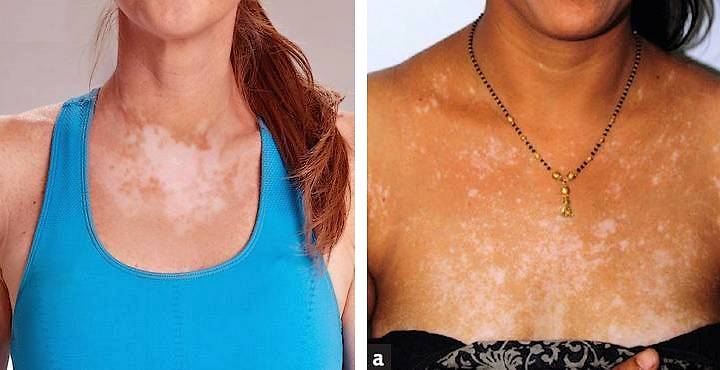
Vitiligo appears on different skin shades in similar percentages and on any part of your body.
Pigmentation disorders can be more noticeable on darker skin, although they know few barriers. Vitiligo in particular is a global condition, affecting over 1% of the population, with an equal spread across men and women.
The condition mainly arises through your immune system attacking pigment producing cells called melanocytes. Other skin conditions can also affect the amount of pigment the body produces, in localised, or wider areas.
Symptoms can include too much melanin production, creating brown patches, or spots. Pigment changes can also be an issue during pregnancy, they normally vanish afterwards but not always.
The patches of pale skin vitiligo produce is still the most common and best known condition to affect the skin’s colour. This can arise at any age, although children and teenagers are the largest group.
If you are looking for support for a child, or teenager, you may wish to see more on vitiligo treatment for children. A careful approach needed, being younger can enhance the loss of self esteem.
Damage to confidence is however understandable at any age, not least as vitiligo can also cause changes in your eyes, or hair colour. The condition is not life threatening but seeking professional support is worthwile.
Diagnosis Of Vitiligo & Pigmentation Changes
Our London clinic ensures all patients are seen by a consultant dermatologist. Whilst a condition such as vitiligo may appear to be evident, this and other pigment changes hold subtle differences, needing thorough evaluation.
The consultant will discuss your longer term medical history, whether there is a history of similar conditions within your family, if you have injured the affected area, been sunburnt, or suffered from other skin issues.
There can be times when scientific analysis will help, a blood test, perhaps a small biopsy, both analysed in our own lab. Trigger conditions need to be considered, such as thyroid issues, other autoimmune diseases, stress, lupus, or diabetes.
In many cases, we can avoid a surgical biopsy, by using advanced diagnostic equipment able to look beneath your skin. This sets aside discomfort, saves time, which can bring treatment forward and adds understanding.
An accurate picture of your condition and any contributing factors is the best route to creating an effective, personal treatment plan.
Treatment For Vitiligo & Pigmentation Issues
There are specialist creams to correct pigmentation changes, steroid creams, although they can cause skin thinning. A group of immune system drugs called calcineurin inhibitors may help, imecrolimus and tacrolimus creams can repigment the skin.
Treatments used cosmetically may be a possibility, such as chemical skin peels, although much of the pigmentation correction and vitiligo treatment in our London clinics focuses on the latest technology.
Narrowband UVB phototherapy can be very effective, often in combination with protopic cream, an immunosuppressant. PUVA is another valuable form of laser treatment, used alongside psoralen, which increases sensitivity to ultraviolet light.
The narrowband Excimer laser can be valuable for vitiligo treatment, particularly smaller areas. This also avoids exposure to longer wavelengths of ultraviolet light, part of our care in ensuring treatment is as safe as possible.
Treating pigment changes requires expertise and the right combination of treatments for each individual case. For some, this can be over a fair period, to achieve, or maintain the solutions they want to see.
The consultants in our London dermatology clinic remain committed throughout your treatment. Combining a scientific approach with a high level of personal care.
You may find the options below useful:
- Alphabetic Dermatology Menu: Conditions & Treatments.
- Up to date news and insight in: Our Dermatology Blog.
For any advice, or to arrange a dermatology appointment, call 020 3535 7850, or send an email via the Make An Appointment button below.
